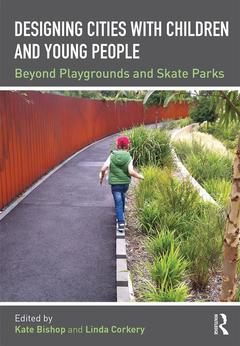Designing Cities with Children and Young People Beyond Playgrounds and Skate Parks
Coordonnateurs : Bishop Kate, Corkery Linda

Designing Cities with Children and Young People focuses on promoting better outcomes in the built environment for children and young people in cities across the world. This book presents the experience of practitioners and researchers who actively advocate for and participate with children and youth in planning and designing urban environments. It aims to cultivate champions for children and young people among urban development professionals, to ensure that their rights and needs are fully acknowledged and accommodated.
With international and interdisciplinary contributors, this book sets out to build bridges and provide resources for policy makers, social planners, design practitioners and students. The content moves from how we conceptualize children in the built environment, what we have discovered through research, how we frame the task and legislate for it, and how we design for and with children. Designing Cities with Children and Young People ultimately aims to bring about change to planning and design policies and practice for the benefit of children and young people in cities everywhere.
Foreword
Introduction
Kate Bishop and Linda Corkery
Part 1: Global and regional initiatives with local value
- Child Friendly Cities: a model of planning for sustainable development
Karen Malone
Victoria Derr, Louise Chawla and Willem van Vliet
Fredrika Martensson and Maria Nordstrom
Linda Corkery
Part 2: Utilizing research with children and young people
Patsy Eubanks Owens
Kate Bishop
Helen Woolley
Penelope Carroll and Karen Witten
Case Studies: Part 1
Part 3: Instruments with impact: legislation and policy
Cathy Sherry
Helen Woolley
Maria Nordström
environment: what are they and how did they come about?
Linda Corkery and Kate Bishop
Part 4: Perspectives from participatory practice with children and young
people
Fiona Robbé
Katina Dimoulias
Mara Mintzer and Debra Flanders Cushing
Angela Million
Conclusion
Kate Bishop and Linda Corkery
Case Studies: Part 2
Index
Kate Bishop PhD is a Senior Lecturer in the Faculty of Built Environment at the University of New South Wales. Her background in environment-behaviour research underpins her teaching, research and her particular area of interest: children, youth and environments. She specializes in the design of environments for children with special needs, pediatric facilities and participatory methodologies with children and young people.
Linda Corkery is an Associate Professor of Landscape Architecture in the Faculty of Built Environment at the University of New South Wales. Her research and teaching focuses on the social dimensions of urban landscapes, including public parklands and open space, urban landscape planning and design, and collaborative design processes. Linda is a Fellow of the Australian Institute of Landscape Architects and a member of the Environmental Design Research Association.
Date de parution : 06-2017
17.8x25.4 cm
Date de parution : 07-2017
17.8x25.4 cm
Thème de Designing Cities with Children and Young People :
Mots-clés :
Child Friendly Cities Initiative; Children’s Outdoor Environments; Commission for Children and Young People; Built Environment Education; child-centered design; Child Friendly Cities; evidence-based design; Children’s Environmental Experiences; design practitioner; Built Environment Policies; social planner; Child Friendly Environment; participatory design; Child Friendly Communities; Child-friendly neighbourhoods; Young People’s Participation; Young People; children's rights to the city; NSW Commission; child impact assessment; Linda Corkery; Swedish Urban Planning; Karen Malone; Kate Bishop; Victoria Derr; Skate Parks; Louise Chawla; UN; Willem van Vliet; UNICEF Report; Fredrika Mårtensson; NSW Department; Maria Nordström; Boulder Journey School; Patsy Eubanks Owens; Nature Play Area; Helen Woolley; Young People’s Perspectives; Penelope Carroll; CABE Space; Karen Witten; Children’s Participation; Cathy Sherry; NSW Parliamentary Committee; Fiona Robbé; Urban Green Spaces Taskforce; Katina Dimoulias; Mara Mintzer; Debra Flanders Cushing; Angela Million



